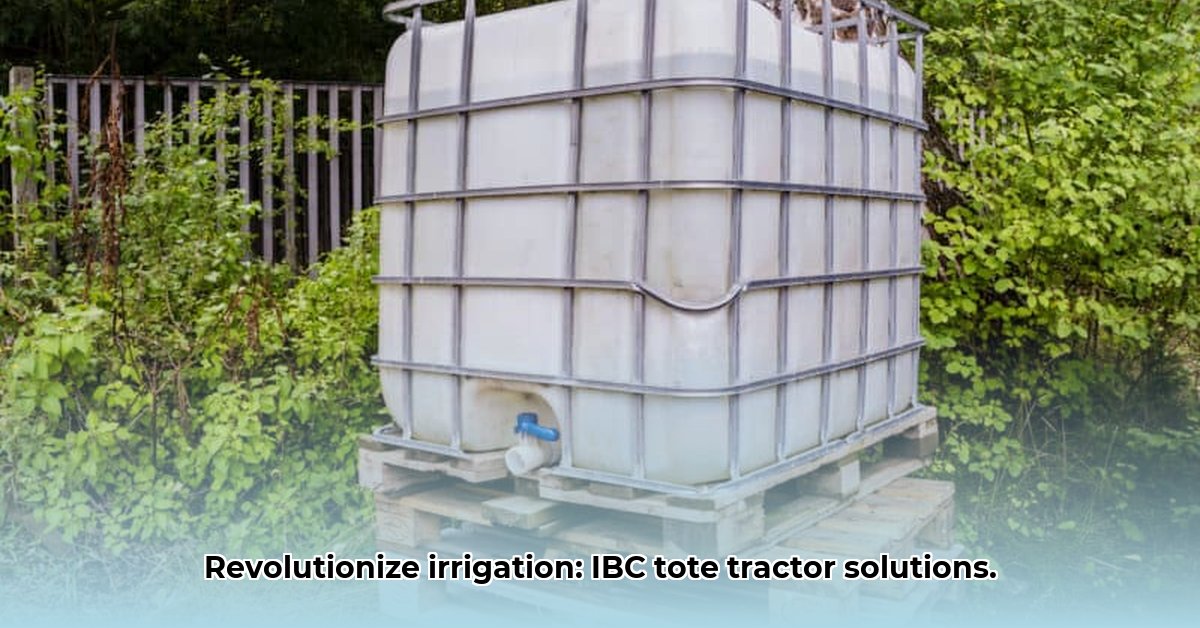
IBC Tote Tractor Supply: Smart Water Management for Your Farm
Water is crucial for successful farming. Efficient and sustainable irrigation is key to maximizing yields and profits. Intermediate Bulk Containers (IBCs), commonly known as totes, are increasingly popular among farmers for water storage and transport. Tractor Supply offers a range of IBC totes, many with a substantial 275-gallon capacity. This significantly reduces the number of trips needed to replenish smaller containers, leading to potential time and water savings. Let's dissect the benefits and challenges of incorporating IBC totes into your irrigation strategy. For efficient water pumping, consider submersible pumps.
IBC Totes: A Deeper Dive into Sustainable Farming Practices
IBCs function like giant, robust water jugs. Their large capacity makes them ideal for storing and transporting significant volumes of water. However, are they the perfect solution for every farm? Let's explore the advantages and disadvantages to determine their suitability for your operation.
Weighing the Pros and Cons of IBC Totes
The following table summarizes the advantages and disadvantages of using IBC totes for farm irrigation:
| Advantages | Disadvantages |
|---|---|
| High Capacity: Stores significantly more water than smaller containers, reducing refill trips. | Higher Initial Cost: IBC totes have a higher upfront cost than smaller containers. |
| Reduced Labor: Fewer trips translate to more time for other farm tasks. | Potential for Leaks: Requires careful handling to prevent damage and leaks. |
| Improved Water Quality: Reduced handling minimizes contamination risks. | Cleaning and Disposal: Regular cleaning and responsible disposal at end-of-life are crucial. |
| Durability and Reusability: Designed for long-term, repeated use, potentially saving money in the long run. | Repair Challenges: Sourcing replacement parts may be difficult depending on location. |
| Variety of Options: Tractor Supply offers various sizes and materials to meet diverse needs. | Space Requirements: Adequate storage space is necessary. |
Implementing IBC Totes: A Practical Guide
Successfully integrating IBC totes involves careful planning. Follow these steps:
- Assess Water Needs: Accurately determine your daily, weekly, and seasonal water requirements to avoid over- or under-purchasing.
- Select Appropriate Totes: Tractor Supply provides various sizes and materials. Choose totes that align with your budget and the specific needs of your crops or livestock. For potable water, ensure FDA approval.
- Strategic Storage and Handling: Store totes in a secure, stable area away from hazards. Implement a safe and efficient system for moving and handling these heavier containers. Consider investing in appropriate equipment.
- Maintain Water Quality: Establish a regular cleaning schedule to prevent algae or bacterial growth. This safeguards water quality and extends the lifespan of your totes.
- Responsible Disposal: Adhere to local regulations and recycling options when your totes reach the end of their useful life.
IBC Tote Costs vs. Traditional Water Storage: A Comparative Analysis
Choosing the right water storage system is key to farm efficiency and profitability. This section compares the costs and benefits of IBC totes against traditional water storage systems.
A Modern Approach to Water Management: IBC Totes
IBCs are increasingly popular due to their portability, affordability, and reusability. However, determining their suitability requires a thorough cost-benefit analysis.
Key Considerations:
- Initial Investment: IBC totes typically have lower upfront costs than building permanent tanks, but bulk discounts can make traditional systems competitive for large-scale operations.
- Maintenance: IBCs require minimal upkeep; regular cleaning is sufficient. Traditional systems may need more frequent maintenance and repairs.
- Water Loss: Evaporation rates vary based on system type, climate, and tank design.
- Lifespan: IBCs, with proper care, can last several years. Traditional tank lifespans depend on materials and maintenance.
- Transport and Handling: IBCs are relatively easy to move, but your existing equipment and terrain influence cost-effectiveness.
A Head-to-Head Comparison: IBCs vs. Traditional Systems
| Feature | IBC Totes | Traditional Water Storage |
|---|---|---|
| Initial Cost | Generally Lower | Generally Higher |
| Maintenance | Low | Moderate to High |
| Portability | High | Low |
| Water Loss | Moderate (potentially higher if uncovered) | Moderate (dependent on design and climate) |
| Environmental Impact | Relatively Low (recyclable) | Varies greatly (material and manufacturing) |
| Lifespan | Several Years | Variable, dependent on materials and maintenance |
Sustainability and Practical Considerations
IBCs promote sustainable practices through reusability, reducing waste. However, proper recycling is essential. Consider:
- Farm Size: IBCs are often cost-effective for smaller farms; larger farms may benefit from a combined approach.
- Water Needs: Irrigation needs or livestock watering affect the necessary storage capacity.
- Local Regulations: Comply with local regulations regarding water storage, tank placement, materials, and safety.
Making the Optimal Choice
The decision between IBC totes and traditional systems demands a data-driven approach. By carefully analyzing the presented factors, you can make an informed choice that optimizes your farm's water management.